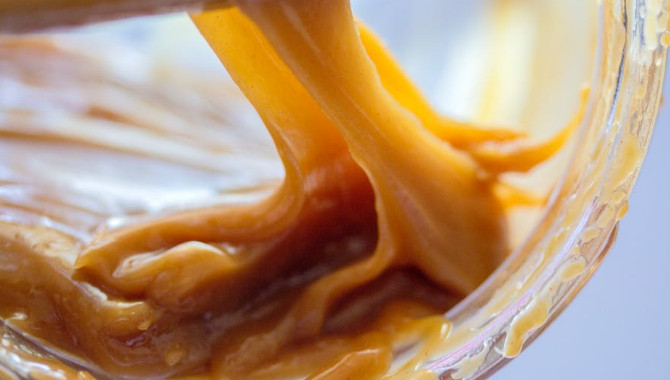Have you ever been to a restaurant, finished your meal and then looked at the dessert menu, only to be met with a list of options that are off-limits for vegans, including ice cream and cakes? For those of us with a sweet tooth, it can be important to find confectionery items that do not use animal products, but this can sometimes be easier said than done. One ingredient that many new vegans wonder about is caramel, which is used in a wide range of different store and restaurant-bought treats and desserts, and which can be used at home to make many more.
So is caramel vegan? It certainly can be and is in its purest form. Yet, unfortunately, much of the pre-made caramel products available to buy in shops are unsuitable for vegans, as they will often contain butter, milk or heavy cream. This can apply to bottled caramel sauce as well.
With that being said, vegan-friendly caramel products do exist and it is relatively simple to make homemade vegan caramel too. All of this means that while vegans do need to be careful when buying products containing caramel, there is no need to miss out on it altogether. In this article, I will cover what caramel is and why it is vegan-friendly in its purest form. I will also go into the various reasons why store-bought caramel is often unsuitable for vegans, how you can steer clear of these items, and how you can enjoy vegan caramel at home.
Common Caramel Ingredients
In its purest form, caramel is completely vegan-friendly, because it can be created through a very simple process of heating pure sugar. A number of different varieties of sugar can be used to create caramel, each with their own temperature at which “caramelisation” takes place. The actual process of caramelisation is still not particularly well understood, but what we do know is that heating sugar beyond a certain temperature causes a chemical reaction to occur, whereby the sugar molecules break down and the sugar itself starts to turn brown.
As the temperature continues to rise, the sugar eventually turns into a liquid. With most sugars, this occurs at around the 170 °C (338 °F) mark, although some varieties of sugar need to be heated to around 180 °C (356 °F). Impurities can also affect the specific temperature needed. To create caramel, all you actually need is some sugar, a saucepan, a wooden spoon and a source of heat, such as a cooker. Therefore, it is important to establish that caramel is vegan-friendly and there is absolutely no reason why a vegan would need to avoid it completely.
It is also relatively straight forward to make too, as I will explain a little later on.
Nevertheless, you may have seen caramel listed in guides as a food that needs to be avoided when sticking to a vegan diet. So what is the source of this confusion and why do vegans need to be careful when buying caramel products?
First, it is crucial to establish that the word “caramel” is actually used to describe a number of different food ingredients or food products. On a basic level, it refers to liquid caramel, which is what I have described above. However, on top of this, the word is also sometimes used to describe caramel sauce – sold in bottles or jars and often used as a dessert topping – as well as caramel candy, or toffee, which is a hard and chewy confection.
With caramel sauce, additional ingredients are usually added, in order to provide a thick and creamy texture. Sadly, in many cases, the ingredients added will be either heavy cream or milk, making it unsuitable for vegans. Caramel candy, meanwhile, it typically made through a combination of sugar, glucose, cream and butter, once again making it off-limits.
Ultimately, this means that many products containing caramel, many desserts that are topped with caramel and many caramel sauces are not compatible with a vegan diet. Vegan alternatives do exist, because milk can be easily replaced by either coconut milk or soy milk, while butter can be replaced by almond butter. However, it is not safe to assume that caramel is vegan unless it is specifically stated as such on the container or packaging.
If a menu in a restaurant lists caramel as an ingredient, there is a good chance the caramel in question will not be vegan. If you are buying a consumer product, check the ingredients list and it should state whether or not milk or cream have been used. Wherever possible, stick to products with clear vegan certification.
The Problem With Sugar
The other potential issue vegans may run into when attempting to find vegan caramel relates to sugar. To be more specific, some types of sugar are filtered and processed in a way that brings the sugar into contact with bone char – otherwise known as natural carbon – which is made from the bones of cattle. Generally, the reason for this process is to strip the colour from the sugar, which is why it is more common with white sugar than with brown sugar.
It is worth pointing out that the sugar resulting from this process does not actually contain any animal products. However, it does come into contact with the bones of an animal. When you were initially deciding on why to become vegan, it is likely that you established your own moral lines, but you may still be trying to figure things out. Some vegans accept the use of bone char to process sugar, but others do not. Personally, I do not consider it to be vegan, because purchasing this kind of sugar still directly contributes to the slaughter of animals.
Some types of sugar, such as beet sugar, are not filtered in this way, because the same level of de-colourisation does not need to be achieved, while some companies are committed to never using bone char.
What makes this dilemma even more difficult is that some supermarket brands source their sugar from multiple different sugar refineries and this effectively makes it impossible to know whether bone char has been used. Therefore, in order to avoid it fully, you need to stick to certified vegan sugar, or contact manufacturers directly to gain clarity.
Of course, with store-bought caramel, there is usually no way of knowing what kind of sugar has been used.
Making Caramel At Home
To get around the various problems and pitfalls associated with caramel, I would recommend attempting to make your own caramel at home. Not only will this guarantee that the caramel you eat is vegan-friendly, it also allows you to use caramel for a range of different treats and snacks that you might otherwise miss out on.
So how do you actually make your own caramel and what equipment do you need?
First, you need to source some vegan-friendly sugar. You will also need a saucepan and a wooden spoon. To begin, pour the sugar into the saucepan. The amount of sugar you use will depend on the amount of caramel you want to make, but around 100 to 150 grams should be sufficient for most uses.
Place the saucepan with the sugar onto a medium heat and leave it to heat the sugar. Eventually, after several minutes, you should begin to see the sugar turn to liquid, starting with the edges. The natural temptation at this point will be to stir it, but you should hold off on this until around 25 percent of the sugar has dissolved. Then, stir gently until all of the sugar turns to liquid and continue to heat it until the caramel darkens a little.
The total cooking time should be somewhere around 10 to 12 minutes, but it may take slightly longer or slightly shorter, depending on the level of heat you are using. You may opt to stir in a pinch of salt too, and if you want to thicken the mixture and give it a creamier texture, you could also add a small amount of coconut or soy milk while it is cooking. Once you are satisfied, take the saucepan off the heat and leave the caramel to cool down.
Vegan-Friendly Caramel Treats
If you make homemade caramel, you can use it as an ingredient or topping for a wide range of different foods, including vegan cakes and muffins. This works best for vegan cakes you have baked from scratch, but the caramel can also be used to add to store-bought vegan cakes too, giving them a more indulgent quality. Vegan pancakes are another excellent option for a homemade treat, and these can be made using egg replacer and almost any non-dairy milk.
One less obvious use of caramel, which I like to experiment with from time-to-time, is using it as a dipping sauce. This is ideal for turning vegan snacks into something a little more adventurous, with examples including fruit and celery sticks. Of course, a natural extension of this is to use the caramel to make caramel or toffee apples. If you are making it as a sauce, it also works as an excellent topping for non-dairy ice cream.
For those who are short on time and looking to buy a vegan caramel-based treat, there are a wide range of confectionery options available, including vegan chocolates, vegan biscuits and vegan toffees. Vegan toffees can also be made easily enough at home and you will find recipes online. Generally, this will involve using coconut milk and vegan butter in place of dairy milk and butter, although some recipes will make additional adjustments too.
Regardless of whether you are making snacks at home or buying them from the supermarket, the crucial thing is to always check ingredients lists. Wherever possible, opt for products that are specifically marketed as being vegan-friendly, or products that are certified as vegan.
In restaurants and other places where ingredients lists may not be available and where caramel or toffee are listed, it is usually best to ask somebody whether they are suitable. If in doubt, it may be best to steer clear.
Welcome to VeganClue - My name is Robert Van De Ville and together with my team we spent hundreds of hours researching the most relevant topics for Vegans and non yet Vegans. Are you looking for more information about Veganism, animal welfare, diet, health, and environmental benefits of the Vegan lifestyle? You are in the right place! Enjoy the site.


